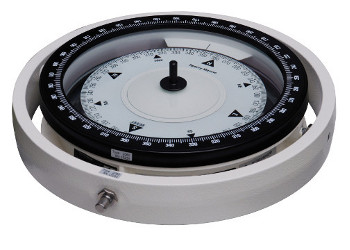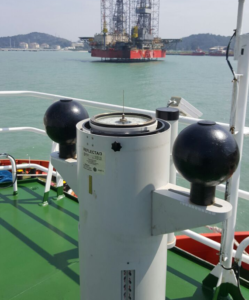
The mystery, the fear and the feeling of – “I don’t want to know” which surrounds the binnacle arises from several causes. Perhaps the greatest is simply the lack of urgency or necessity. There seems to be nothing abroad ship which makes it essential that the navigator should remove unwanted deviation. It is not even a habit like taking an eight o’clock sight and running it up to noon – a rather useless exercise of navigation anyway.
Cross bearings are taken; and compass errors are observed; the radar, echo-sounder and GPS are all switched on and off as occasion demands, and rightly so; then why not move a magnet or two and get rid of a few degrees of deviation? If complete or even partial adjustment were a habit or a routine it would become second nature, casually accepted and no fuss made about it – in fact one would then say “everyone does it at sea”.
But there are further reasons why we don’t – the most likely is that since the subject was put on the map in 1879 the theoretical extent to which it has been taken has frightened any remaining enthusiasts off it altogether. Most of the details are, or have in fact been, mastered by qualifying officers with no small effort and with some success
Up on the Compass Platform
Go on the compass platform; open the corrector locker doors, you’ll find some fore and aft magnets and some athwart ship magnets, probably five or six of each. The former lie lengthwise fore and aft and the latter lengthwise athwartships. Count their number, note which slots they occupy, record whether the red or blue end is visible at the open end of the slot.
Breaking the Ice (Step I)
Some time or other you will steer a course between 170°(C) and 190°(C). Just mark the occasion especially if the weather is good and the sun is shining. You have a quarter of an hour to spare. Perhaps between 1000 and 1015 hours local ship’s time. List the true bearings of the sun at four-minute intervals (four minutes is useful when using azimuth tables) covering the chosen quarter hour. Apply the local variation and record the corresponding magnetic bearings against local time. Let us assume the standard compass course is not many degrees direct from 180 deg with the ship on auto-helm on a corresponding gyro course. The precise course is immaterial. Observe the compass bearing of the sun, for example 106° (C).
Note the difference between this and the magnetic bearing listed for the time by your watch (local ship’s time), e.g. 111° (M). The deviation on the present course is clearly 5°E. At this point it doesn’t really matter at all whether the deviation is easterly or westerly.
The deviation is 5° and it is better to remove it than let it remain.This can be done in a few moments by noting the assembly of athwart ship magnets,
appreciating the possibility of either rising or lowering one or two of them, or adding another one to the number already there. With no technical knowledge the navigator will still have no difficulty in removing the deviation by tentatively altering the positions and/or number of the athwart ship corrector magnets. The deviation will be reduced to zero when
compass and magnetic bearings are made to be the same, namely 111°(M) in this case. Since the auto-helm is steering the ship there is no difficulty in making the steering magnetic compass show the same heading as the standard magnetic compass, in which event the deviation at both compasses has been reduced to zero provided that the lubber lines at berth compasses are aligned to the fore and aft line of the ship, a fact which must
be accepted at this point. The additional correction at the steering compass while the “adjuster” moves the athwart ship magnets at the steering position.
This very simple procedure of removing the deviation on a course to 1800 is one of the easiest and most useful tentative adjustments. There are no complications; the deviation is automatically and simultaneously removed for courses close to 000° and the correction will not deteriorate for some time even after substantial changes of latitude have occurred.
The actual alteration in the position and number of athwart ship magnets should be carefully recorded in the deviation journal with a note of the date, time and geographical position. Had the ship been pursuing a course close to 000° instead of 180° the process would have been identical. This is merely a matter of circumstance.
Step 2

The entirely painless and extremely simple process of adjusting the athwart ship magnets to eliminate the deviation on northerly and southerly courses surprises the navigator who has never done it before to the extent that he wonders why, for so many years, he never tried. Having overcome the inertia once, he is tempted to try again, and the obvious suggests itself – to reduce the deviation on easterly and westerly courses to zero by following the same process as before only on this occasion the magnets to move are
those which are positioned lengthwise in the slots which the parallel to the fore and aft line. These are the fore and aft magnets. In other respects the sequence is identical.
A list of magnetic bearings of the sun at small intervals of time is again prepared on a suitable occasion when the weather is fine with the ship on a course within 10° either side of 090° or 270°. One or more fore and aft magnets are raised or lowered so that the compass bearing of the sun is made identical with the magnetic bearing on the prepared list for the appropriate instant of time. In the event the tentative movements of the
magnets may be unsuccessful. It may be necessary to introduce an additional magnet. Such spares should be readily available.
Having removed the deviation all the relevant details should once more be recorded in the deviation journal. Since we have, in present context, divested the subject of its official language, it is wise to point out that there are some special circumstances, which attend the corrections on easterly and westerly courses.
For the moment they do not matter because the navigator is doing substantially the same as any compass adjuster would do in practice.
Step 3
Pursuing this pattern of sighting the deviation and watching it disappear so easily, with so little trouble, and with no more knowledge than that required to work out a time azimuth, it seems only logical to complete the job for what is called the “upright condition” by likewise reducing to zero any observed deviation which appears whenever the ship pursues a course close to any one of the intercardinal headings 045°(C), 135°(C), 225°(C) or 315°(C).
Once more the magnetic bearings of the sun are pre computed and
listed against local ship’s time. The holding down bolts of the sphere correctors are slackened. With the ship on a course within about 5° of any of the quadrantal headings mentioned the deviation is observed as before.

On this occasion the compass and magnetic bearings of the sun for the instant are made identical by moving each sphere corrector a similar amount either towards the compass or further away from it. Movements
of approximately half an inch (12mm) for each sphere should be attempted and both spheres should be moved in the same sense nearer to or further away from the compass.
After making these small adjustments the spheres should be disposed symmetrically on each side. Again, a complete record of the event should be entered in the deviation journal.
Some Warnings
Although the simplicity of steps 1, 2 and 3 may be effected at any time as opportunity offers, it would be unwise to assume that this is all there is to compass adjustment. The correction of inclination errors has been omitted at this stage intentionally, as well as some other important details, but this is not to say that there has been an oversimplification. The important points, which emerge, may be listed.
The Achievement
(i) For the upright condition deviations on all headings are substantially zero, the directive force has been equalized and the compass steadier in consequence.
(ii) The correction will remain valid except for cases where very large changes of latitude are made, in which event the process can be repeated when opportunity offers.
(iii) The experienced gained is inevitable because doing the job instead of talking about it and being afraid of it has convinced the navigator that most of the fears were born of ignorance and were largely imagined. The foundation to a better understanding has been laid
“Licking the Compass into Shape”
The sequences which have been detailed should be preserved if possible and while there is some license over Steps 1 and 2 in so far as they may be done in the reverse order it is important in so far as they may be done in the reverse order it is important to effect the adjustment of the spheres last.
There is some opinion, wholly misguided, which suggests and initial adjustment of the spheres on any single intercardinal heading. This is
most unwise (except in the case of what is called an analysis adjustment), completely wrong in both theory and practice and should never be done.
Any attempt at “licking the compass into shape” by an indiscriminant attack on the deviation is to be deprecated most strongly.

Great content! Super high-quality! Keep it up! 🙂